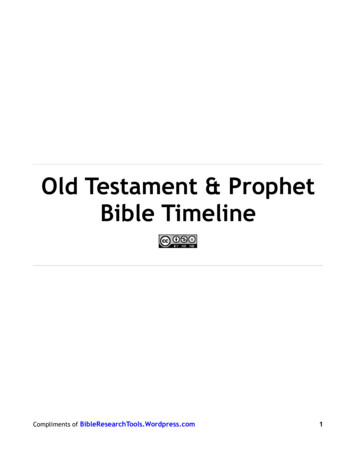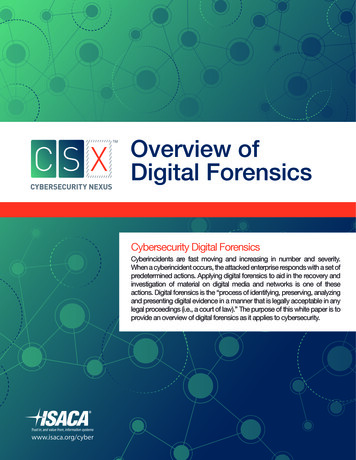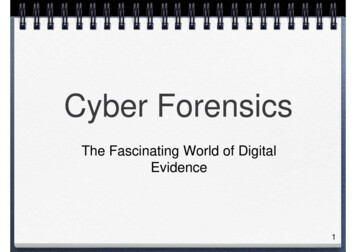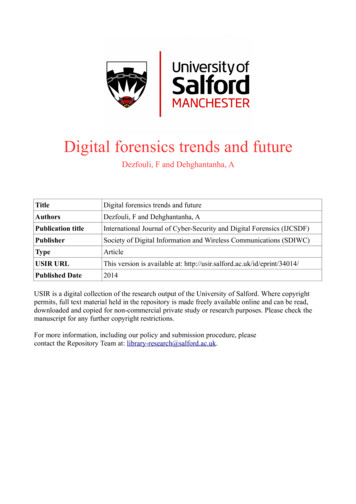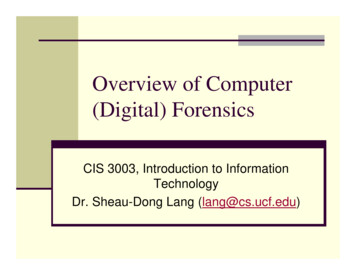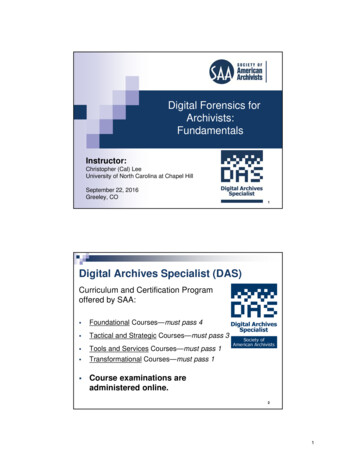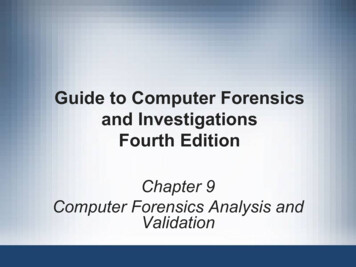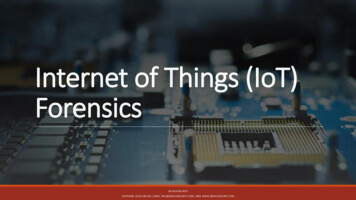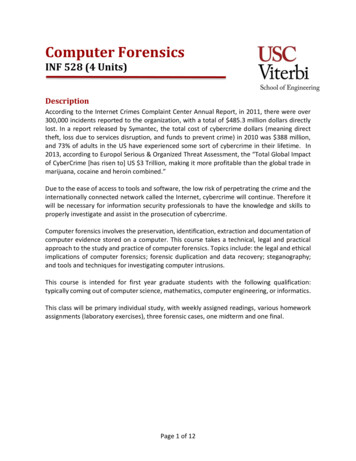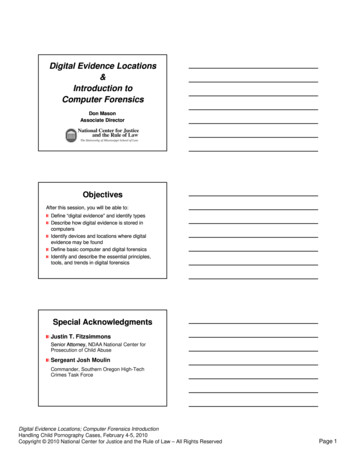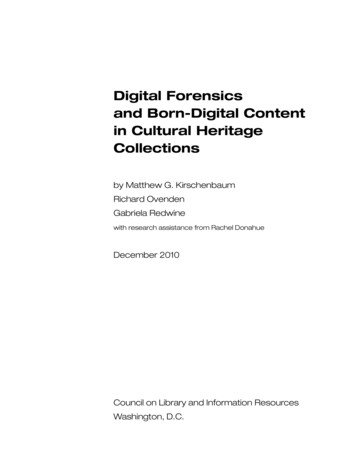
Transcription
Digital Forensicsand Born-Digital Contentin Cultural HeritageCollectionsby Matthew G. KirschenbaumRichard OvendenGabriela Redwinewith research assistance from Rachel DonahueDecember 2010Council on Library and Information ResourcesWashington, D.C.
ISBN 978-1-932326-37-6CLIR Publication No. 149Published by:Council on Library and Information Resources1752 N Street, NW, Suite 800Washington, DC 20036Web site at http://www.clir.org8Additional copies are available for 25 each. Orders must be placed through CLIR’s Web site.This publication is also available online at The paper in this publication meets the minimum requirements of the American National Standardfor Information Sciences—Permanence of Paper for Printed Library Materials ANSI Z39.48-1984.Copyright 2010 by the Council on Library and Information Resources. No part of this publication may be reproduced or transcribedin any form without permission of the publisher. Requests for reproduction or other uses or questions pertaining to permissionsshould be submitted in writing to the Director of Communications at the Council on Library and Information Resources.Cover photo collage: Inside view of a hard drive, by SPBer, licensed under Creative Commons; On The Road Manuscript #3, byThomas Hawk, licensed under Creative Commons.Library of Congress Cataloging-in-Publication DataKirschenbaum, Matthew G.Digital forensics and born-digital content in cultural heritage collections / by Matthew G. Kirschenbaum, Richard Ovenden,Gabriela Redwine ; with research assistance from Rachel Donahue.p. cm. -- (CLIR publication ; no. 149)Includes bibliographical references.ISBN 978-1-932326-37-6 (alk. paper)1. Electronic records--Management. 2. Archives--Administration. 3. Digital preservation. 4. Archives--Data processing. 5.Archives--Administration--Technological innovations. 6. Forensic sciences. 7. Humanities--Data processing. I. Ovenden, Richard.II. Redwine, Gabriela. III. Donahue, Rachel. IV. Title. V. Series.CD974.4.K57 2010070.5’797--dc222010048734
iiiContentsAbout the Authors . . . . . . . . . . . . . . . . . . . . . . . . . . . . . . . . . . . . . . . . . . . . . . . . . . . . . vConsultants . . . . . . . . . . . . . . . . . . . . . . . . . . . . . . . . . . . . . . . . . . . . . . . . . . . . . . . . . . . viAcknowledgments . . . . . . . . . . . . . . . . . . . . . . . . . . . . . . . . . . . . . . . . . . . . . . . . . . . . . viForeword . . . . . . . . . . . . . . . . . . . . . . . . . . . . . . . . . . . . . . . . . . . . . . . . . . . . . . . . . . . . vii1.2.3.Introduction . . . . . . . . . . . . . . . . . . . . . . . . . . . . . . . . . . . . . . . . . . . . . . . . . . . . . . 11.1. Purpose and Audience . . . . . . . . . . . . . . . . . . . . . . . . . . . . . . . . . . . . . . . . 21.2. Terminology and Scope . . . . . . . . . . . . . . . . . . . . . . . . . . . . . . . . . . . . . . . 31.3. Background and Assumptions . . . . . . . . . . . . . . . . . . . . . . . . . . . . . . . . . 51.4. Prior Work . . . . . . . . . . . . . . . . . . . . . . . . . . . . . . . . . . . . . . . . . . . . . . . . . . 81.5. About This Report . . . . . . . . . . . . . . . . . . . . . . . . . . . . . . . . . . . . . . . . . . 13Challenges . . . . . . . . . . . . . . . . . . . . . . . . . . . . . . . . . . . . . . . . . . . . . . . . . . . . . . 142.1. Legacy Formats . . . . . . . . . . . . . . . . . . . . . . . . . . . . . . . . . . . . . . . . . . . . . 142.1.1. File System . . . . . . . . . . . . . . . . . . . . . . . . . . . . . . . . . . . . . . . . . . . . 152.1.2. Operating System and Application . . . . . . . . . . . . . . . . . . . . . . . 172.1.3. Hardware . . . . . . . . . . . . . . . . . . . . . . . . . . . . . . . . . . . . . . . . . . . . . 192.1.4. Conclusions . . . . . . . . . . . . . . . . . . . . . . . . . . . . . . . . . . . . . . . . . . . 212.2. Unique and Irreplaceable . . . . . . . . . . . . . . . . . . . . . . . . . . . . . . . . . . . . 232.2.1. Materials at Risk . . . . . . . . . . . . . . . . . . . . . . . . . . . . . . . . . . . . . . . 232.2.2. Forensics . . . . . . . . . . . . . . . . . . . . . . . . . . . . . . . . . . . . . . . . . . . . . . 252.3. Trustworthiness . . . . . . . . . . . . . . . . . . . . . . . . . . . . . . . . . . . . . . . . . . . . . 262.3.1. Tracking Trust . . . . . . . . . . . . . . . . . . . . . . . . . . . . . . . . . . . . . . . . . 272.3.2. Intermediaries . . . . . . . . . . . . . . . . . . . . . . . . . . . . . . . . . . . . . . . . . 282.3.3. Repositories . . . . . . . . . . . . . . . . . . . . . . . . . . . . . . . . . . . . . . . . . . . 292.3.4. Forensics . . . . . . . . . . . . . . . . . . . . . . . . . . . . . . . . . . . . . . . . . . . . . . 312.4. Authenticity . . . . . . . . . . . . . . . . . . . . . . . . . . . . . . . . . . . . . . . . . . . . . . . . 322.4.1. Origination and Identification . . . . . . . . . . . . . . . . . . . . . . . . . . . . 342.4.2. Data Integrity and Fixity . . . . . . . . . . . . . . . . . . . . . . . . . . . . . . . . 352.4.3. Preaccession . . . . . . . . . . . . . . . . . . . . . . . . . . . . . . . . . . . . . . . . . . . 382.4.4. Postaccession . . . . . . . . . . . . . . . . . . . . . . . . . . . . . . . . . . . . . . . . . . 382.5. Data Recovery . . . . . . . . . . . . . . . . . . . . . . . . . . . . . . . . . . . . . . . . . . . . . . 392.5.1. Remanence . . . . . . . . . . . . . . . . . . . . . . . . . . . . . . . . . . . . . . . . . . . . 402.5.2. File Systems . . . . . . . . . . . . . . . . . . . . . . . . . . . . . . . . . . . . . . . . . . . 432.5.3. Forensics . . . . . . . . . . . . . . . . . . . . . . . . . . . . . . . . . . . . . . . . . . . . . . 452.5.4. Conclusions . . . . . . . . . . . . . . . . . . . . . . . . . . . . . . . . . . . . . . . . . . . 462.6. Costing . . . . . . . . . . . . . . . . . . . . . . . . . . . . . . . . . . . . . . . . . . . . . . . . . . . . 47Ethics . . . . . . . . . . . . . . . . . . . . . . . . . . . . . . . . . . . . . . . . . . . . . . . . . . . . . . . . . . 493.1. Security Issues . . . . . . . . . . . . . . . . . . . . . . . . . . . . . . . . . . . . . . . . . . . . . . 513.1.1. Access Controls and Oversight of Use . . . . . . . . . . . . . . . . . . . . . 52
iv3.2. Privacy . . . . . . . . . . . . . . . . . . . . . . . . . . . . . . . . . . . . . . . . . . . . . . . . . . . . 533.2.1. Conduct and Confidentiality . . . . . . . . . . . . . . . . . . . . . . . . . . . . . 533.2.2. Recruitment, Training, and Encouragement of Staff . . . . . . . . . 553.3. Working with Data Creators . . . . . . . . . . . . . . . . . . . . . . . . . . . . . . . . . . 564.Conclusions and Recommendations . . . . . . . . . . . . . . . . . . . . . . . . . . . . . . . . 594.1. Next Steps . . . . . . . . . . . . . . . . . . . . . . . . . . . . . . . . . . . . . . . . . . . . . . . . . 62Reference List . . . . . . . . . . . . . . . . . . . . . . . . . . . . . . . . . . . . . . . . . . . . . . . . . . . . . . . . 65Appendix A: Forensic Software . . . . . . . . . . . . . . . . . . . . . . . . . . . . . . . . . . . . . . . . . 70Appendix B: Forensic Hardware . . . . . . . . . . . . . . . . . . . . . . . . . . . . . . . . . . . . . . . . 81Appendix C: Further Resources . . . . . . . . . . . . . . . . . . . . . . . . . . . . . . . . . . . . . . . . . 85Appendix D: The Maryland Symposium . . . . . . . . . . . . . . . . . . . . . . . . . . . . . . . . . 92FiguresFigure 1.1: An assortment of disks from the Ransom Center’s collection . . . . . . . 1Figure 2.1: Laptops in the Ransom Center’s collection . . . . . . . . . . . . . . . . . . . . . 19Figure 2.2: Magnetic Force Microscopy image of data on the surfaceof a hard disk . . . . . . . . . . . . . . . . . . . . . . . . . . . . . . . . . . . . . . . . . . . . . . . . . . . . 41Figure 2.3: Available settings in a common Windows file erase utility . . . . . . . . 42Figure 2.4: A hex utility revealing the text of a “deleted” document ona Windows file system . . . . . . . . . . . . . . . . . . . . . . . . . . . . . . . . . . . . . . . . . . . . 44SidebarsDiplomatics, by Luciana Duranti . . . . . . . . . . . . . . . . . . . . . . . . . . . . . . . . . . . . . . . . . 10A Digital Forensics Workflow, by Brad Glisson and Rob Maxwell . . . . . . . . . . . . . . 16Rosetta Computers, by Doug Reside . . . . . . . . . . . . . . . . . . . . . . . . . . . . . . . . . . . . . . 20Digital Forensics at Stanford University Libraries, by Michael Olson . . . . . . . . . . 30Digital Forensics at the Bodleian Libraries, by Susan Thomas . . . . . . . . . . . . . . . . 36Donor Agreements, by Cal Lee . . . . . . . . . . . . . . . . . . . . . . . . . . . . . . . . . . . . . . . . . . 57
vAbout the AuthorsMatthew G. Kirschenbaum is associate professor in the Department ofEnglish at the University of Maryland and associate director of the MarylandInstitute for Technology in the Humanities (MITH). Much of his work now focuses on the intersection between literary scholarship and born-digital cultural heritage. His first book, Mechanisms: New Media and the Forensic Imagination,was published by the MIT Press in 2008 and won the 16th annual Prize for aFirst Book from the Modern Language Association. Kirschenbaum was theprincipal investigator for the National Endowment for the Humanities project“Approaches to Managing and Collecting Born-Digital Literary Materials forScholarly Use” (2008), and is a co-principal investigator for the PreservingVirtual Worlds project, funded by the Library of Congress’s National DigitalInformation Infrastructure and Preservation Program and the Institute ofMuseum and Library Services.Richard Ovenden is associate director and keeper of special collections ofthe Bodleian Libraries, University of Oxford, and a professorial fellow at StHugh’s College, Oxford. He has worked at Durham University Library, theHouse of Lords Library, the National Library of Scotland, and the Universityof Edinburgh. He has been in his present role at Oxford since 2003. He is theauthor of John Thomson (1837–1920): Photographer (1997) and A Radical’s Books(1999). He is director of the futureArch Project at the Bodleian, and chair ofthe Digital Preservation Coalition.Gabriela Redwine is archivist and electronic records/metadata specialistat the Harry Ransom Center, where she is responsible for developing andimplementing digital preservation policies and procedures, processing paperbased archives, and reviewing EAD. She earned her B.A. in English from YaleUniversity and her M.S. in Information Science and M.A. in Women’s andGender Studies from The University of Texas at Austin.Rachel Donahue is a doctoral student at the University of Maryland’siSchool, researching the preservation of complex, interactive digital objects,especially video games; she is also a research assistant at the MarylandInstitute for Technology in the Humanities (MITH). Donahue received a B.A.in English and Illustration from Juniata College in 2004, and an M.L.S. witha specialization in archival science from the University of Maryland in 2009.In 2009, she was elected for a three-year term to the Society of AmericanArchivists’ (SAA) Electronic Records Section steering committee.
viConsultantsLuciana Duranti, University of British ColumbiaW. Bradley Glisson, University of GlasgowCal Lee, University of North Carolina at Chapel HillRob Maxwell, University of MarylandDoug Reside, University of MarylandSusan Thomas, Bodleian LibrariesAcknowledgmentsThe research and writing of this report, as well as the May 2010 symposiumat the University of Maryland, were made possible by an award from TheAndrew W. Mellon Foundation. The authors are deeply grateful for this support, and for the advice and assistance of foundation officers Helen Cullyerand Donald J. Waters. Likewise, the authors are grateful to Christa Williford,our program officer at CLIR, and to Kathlin Smith at CLIR, who expertlyoversaw the copyediting and production of the report.Rachel Donahue, an archives doctoral student at the University ofMaryland’s iSchool, provided research and editorial assistance throughoutthe project, was instrumental in organizing the May symposium, and assumed primary responsibility for compiling Appendixes A and B. Her contributions have been essential. Chris Grogan at the Maryland Institute forTechnology in the Humanities oversaw our accounting. The Harry RansomCenter graciously supported our work through contributions of GabrielaRedwine’s time.Several paragraphs in sections 1.3 and 2.5 of this report first appearedin slightly different form in Kirschenbaum’s Mechanisms: New Media and theForensic Imagination (2008). We are grateful to the MIT Press for permission toreuse them.We are deeply indebted to our consultants, who read and commented onour drafts, wrote sidebars, and saved us from at least some potential pratfalls:Luciana Duranti, Brad Glisson, Cal Lee, Rob Maxwell, Doug Reside, andSusan Thomas.We are also indebted to other individuals who commented on our draftsor otherwise assisted, including Cynthia Biggers, Paul Conway, Neil Fraistat,Patricia Galloway, Simson Garfinkel, Jeremy Leighton John, Kari M. Kraus,Jerome McDonough, Michael Olson (who also authored one of the sidebars),Catherine Stollar Peters, Andrew Prescott, Virginia Raymond, and SeamusRoss.The authors alone assume full responsibility for any errors ormisstatements.
viiForewordDigital Forensics and Born-Digital Content in Cultural Heritage Collections examines digital forensics and its relevance for contemporary research. The applicability of digital forensics to archivists, curators, and others working withinour cultural heritage is not necessarily intuitive. When the shared interests ofdigital forensics and responsibilities associated with securing and maintaining our cultural legacy are identified—preservation, extraction, documentation, and interpretation, as this report details—the correspondence betweenthese fields of study becomes logical and compelling.There is a palpable urgency to better understanding digital forensics asan important resource for the humanities. About 90 percent of our recordstoday are born digital; with a similar surge in digital-based documentationin the humanities and digitally produced and versioned primary sources, interpreting, preserving, tracing, and authenticating these sources requires thegreatest degree of sophistication.This report makes many noteworthy observations. One is the porosityof our digital environment: there is little demarcation between various storage methods, delivery mechanisms, and the machines with which we access,read, and interpret our sources. There is similarly a very thin line, if any,between the kind of digital information subject to forensic analysis and thatof, for example, literary or historical studies. The data, the machines, and themethods are almost aggressively agnostic, which in turn allows for such extraordinary and unprecedented interdisciplinarity.As this report notes, whether executing a forensic analysis of a suspectedcriminal’s hard drive or organizing and interpreting a Nobel laureate’s“papers,” we are tunneling through layer upon layer of abstraction. The morewe can appreciate and respond to this new world of information, the more effective we will become in sustaining it and discovering new knowledge within it. This requires not only a broader recognition of complementary work inwhat were once considered disparate or tangential fields of study, but alsobuilding new communities of shared interest and wider discourse.Charles HenryPresidentCouncil on Library and Information Resources
viii
Digital Forensics and Born-Digital Content in Cultural Heritage Collections1. IntroductionDigital forensics is an applied field originating in law enforcement, computer security, and national defense. It is concerned with discovering, authenticating, and analyzing datain digital formats to the standard of admissibility in a legal setting.While its purview was once narrow and specialized (catching blackhat hackers or white-collar cybercriminals), the increasing ubiquityof computers and electronic devices means that digital forensics isnow employed in a wide variety of cases and circumstances. Thefloppy disk used to pinpoint the identity of the “BTK Killer” andthe GPS device carried by the Washington, DC, sniper duo—both ofwhich yielded critical trial evidence—are two high-profile examples.Digital forensics is also now routinely used in counter-terrorism andmilitary intelligence.While such activities may seem happily removed from the concerns of the cultural heritage sector, the methods and tools developed by forensics experts represent a novel approach to key issuesand challenges in the archives and curatorial community. Libraries,special collections, and other collecting institutions increasingly receive computer storage media (and sometimes entire computers) aspart of their acquisition of “papers” from contemporary artists, writers, musicians, government officials, politicians, scholars, scientists,Fig. 1.1: An assortment of disks fromthe Ransom Center’s collection.Photographer: Pete Smith, Harry RansomCenter, The University of Texas at Austin.1
2Matthew G. Kirschenbaum, Richard Ovenden, Gabriela Redwineand other public figures. Smart phones, e-book readers, and otherdata-rich devices will surely follow. For governmental, corporate,and organizational repositories, meanwhile, the stakes are similar:ARMA International estimates that upwards of 90 percent of the records being created today are born digital (Dow 2009, xi).The same forensics software that indexes a criminal suspect’shard drive allows the archivist to prepare a comprehensive manifestof the electronic files a donor has turned over for accession; the samehardware that allows the forensics investigator to create an algorithmically authenticated “image” of a file system allows the archivist toensure the integrity of digital content once captured from its sourcemedia; the same data-recovery procedures that allow the specialist todiscover, recover, and present as trial evidence an “erased” file mayallow a scholar to reconstruct a lost or inadvertently deleted versionof an electronic manuscript—and do so with enough confidence tostake reputation and career.Digital forensics therefore offers archivists, as well as an archive’s patrons, new tools, new methodologies, and new capabilities.Yet as even this brief description must suggest, digital forensics doesnot affect archivists’ practices solely at the level of procedures andtools. Its methods and outcomes raise important legal, ethical, andhermeneutical questions about the nature of the cultural record, theboundaries between public and private knowledge, and the rolesand responsibilities of donor, archivist, and the public in a new technological era.1.1. Purpose and AudienceThe purpose of this report is twofold: first, to introduce the field ofdigital forensics to professionals in the cultural heritage sector; andsecond, to explore some particular points of convergence betweenthe interests of those charged with collecting and maintaining borndigital cultural heritage materials and those charged with collectingand maintaining legal evidence. A third purpose is implicit in thefirst two; namely, to serve as a catalyst for increased contact betweenexpert personnel from these two seemingly disparate fields, therebyhelping create more opportunities for knowledge exchange as wellas, where appropriate, the development of shared research agendas.Given these objectives, the primary audience for this report isprofessionals in the cultural heritage sector charged with preserving and providing access to born-digital content in their collections,especially in manuscript collections and in archives. We also hopethat the report will be of some interest to those in legal or industrysettings, not least in terms of building awareness of additional constituencies for their methods and tools. In fact, the distance betweenthe two fields may be overstated. There are deep historical connections between the emergence of archival science and the Roman lawof antiquity, founded on concepts such as chain of custody. (The forensics of modern evidentiary standards is etymologically rooted inthe forensics of verbal disputation—“forensics” comes from the Latinforensis, “before the forum.”)
Digital Forensics and Born-Digital Content in Cultural Heritage CollectionsOther possible audiences for this report include funders (whomay be called upon to help implement the recommendations in section 4.1), depositors, and dealers, who will likely play an increasingrole in valuating and brokering born-digital materials. The role ofthe latter in particular should not be overlooked, since it seems likelythat until there is a recognized marketplace for born-digital content,archives and collections will continue to acquire it in a more or lesshaphazard manner.Finally, the report ought to be of interest to scholars whose research necessitates the use of born-digital collections, and especiallyto textual scholars or to anyone interested in the technologies ofdocuments or records and their storage and transmission. As highprofile examples such as the Salman Rushdie digital papers at EmoryUniversity Libraries or the Stephen Jay Gould collection at StanfordUniversity Libraries illustrate, any scholar working on topics in literary studies, cultural studies, art, music, film, theater, history, politics,or science from the 1980s forward will likely confront born-digitalmaterials among her primary sources. Those scholars who lack wellgrounded knowledge of the technical makeup of these materials willrisk unknowingly compromising or truncating their investigations.While portions of this report are necessarily technical, the archivist who wishes to become a capable forensics practitioner will needto look elsewhere for formal education and training. We make noclaim of having written a how-to guide or field manual. Under nocircumstances should this report be regarded as sufficient preparationfor anyone seeking to conduct a digital forensic investigation. Publications and resources for further study are listed in Appendix C.1.2. Terminology and ScopeAs Eoghan Casey notes, the term computer forensics is a “syntacticalmess” that “uses the noun computer as an adjective and the adjectiveforensic as a noun” (2004, 31). Digital forensics, our term of choice,fares no better with regard to syntax but has become increasinglycommon and enjoys wider scope, encompassing devices that are not,strictly speaking, computers. Forensic computing is also sometimesproffered, but there the gerund presents its own issues for usage.Digital heritage forensics and digital records forensics have been suggested by Duranti (2009). Casey himself favors digital evidence examination, but this seems too narrowly legalistic for our purposes. Wehave thus opted for digital forensics for the sake of its inclusivity andincreasingly widespread recognition. (E-discovery is a neighboringterm that refers to locating electronic evidence in civil litigation.)Digital forensics breaks down into several subfields. Incidentresponse is the branch of computer security and forensics that dealswith the first responder on the scene of an actual crime or incident.This kind of fieldwork does have some relevance to the archivist,who may be charged with collecting computers and other hardware or media from a remote site. Certain routine practices for thecrime scene investigator, such as obtaining still-image and video3
4Matthew G. Kirschenbaum, Richard Ovenden, Gabriela Redwinedocumentation, are useful in an archival context, where aspects ofthe computer’s original setting (e.g., Did the user work with a tandem display?) might be relevant to later inquiries. Intrusion detection, meanwhile, is primarily the domain of systems administratorsand security experts who work to counter active threats and collectevidence from compromised systems. Investigators working in intrusion detection are used to operating on “live” computers, meaningmachines that are still turned on or connected to a network at thetime of the expert’s intervention. This seems an unlikely scenariofor an archivist, though in the future perhaps not too far afield for arecords manager, and of course archives with online content mustthemselves guard against hostile network-based attacks. For themost part, however, the file system will be the premier locus of activity for a practitioner employing digital forensics in a cultural heritagesetting. If a complete computer (as opposed to removable media)is involved, the machine can be assumed to be turned off when itcomes into the archivist’s possession. File system forensics, as opposedto intrusion detection and incident response, will thus be our focushere.Finally, there are the emerging domains of Web and mobile forensics, driven by the recent and rapid rise of cloud computing andWeb 2.0 services and mobile devices like smart phones and personaldigital assistants (PDAs). Many high-profile individuals (writers,politicians, and others likely to become donors of personal papers)lead active online lives, participating in communities like Facebook,MySpace, Flickr, Google (and using applications like Google Docs),Twitter, and even virtual worlds like Second Life. E-mail may bestored locally, in the cloud, or both. The challenges here are legal aswell as technical: different Web services are governed by differentend-user license agreements, and too often these do not include provisions for access even by family members or next of kin, let alonearchivists. Remote backup providers like iDisk or Carbonite presentthe same issues. It is not difficult to foresee a time when hands-onaccess to a physical piece of media containing the data of interestwill be the rarity for the archivist. Similarly, the growing popularityof smart phones, PDAs, tablet computers, and other devices with thepotential to store all manner of information, including e-mail, text,video, voice messages, contacts, Web-browsing activity, and more,will present new challenges for the archivist in the not-too-distantfuture. Indeed, mobile forensics is already a major growth area inthe commercial forensics industry and even in the consumer market,where readily available subscriber identity module (SIM) card readers facilitate the recovery of deleted contacts and text messages.There are no absolute boundaries between the cloud and a localfile system, or between mobile devices and a file system. Browsercaches may reveal evidence of online activity, passwords for Webservices may be discovered on local systems (or even on notes inthe desk drawer next to them), and mobile devices may back up toa desktop or laptop computer—or the cloud. Future archivists willclearly need to contend with a fluid information ecology spanning all
Digital Forensics and Born-Digital Content in Cultural Heritage Collectionscurrent classes of devices and services. For the time being, however,especially as archivists contend with the legacy of the first severaldecades of personal computing, local file systems and removable media are likely to remain the primary venue for their work. Hence ourfocus here.1.3. Background and AssumptionsAny field that concerns itself with the “preservation, identification,extraction, documentation, and interpretation” of recorded eventswould seem to require no special pleading for the attention of thearchivist, scholar, or other steward of cultural heritage (Kruse andHeiser 2002, 2). Only the object of these activities—namely, digitaldata, which are seemingly abstract, numeric, or symbolic as opposedto embodied and material—could possibly raise questions of relevance for the cultural heritage professional. In fact, however, digitalforensics forces its practitioners to confront precisely the dual identity of digital data both as an abstract, symbolic entity and as materialmarks or traces indelibly inscribed in a medium.In the forensic sciences, the most relevant precedent for digitalforensics is the field of questioned document examination, whichdates to the end of the nineteenth century. Questioned documentexamination concerns itself with the physical evidence related towritten and printed documents, especially handwriting attributionand the identification of forgeries. While digital data may seem volatile and ephemeral, gone forever at the flip of a switch or maddeningly out of reach even if the device is in the palm of one’s hand, infact stored data have a measurable physical presence in the world.Stored data are possessed of length and breadth, a fact that accountsfor what is known as the areal density of a given piece of storage media—literally, how closely bits can be packed together on a discretesurface. (Advances in areal density are what explain the astonishingrise in the capacity of hard drives, outstripping even Moore’s law,which projects that the speed of microprocessors doubles every twoyears.) Currently, areal density on hard drives is upwards of 100 billion bits per square inch. Some scientists argue that we are approaching the superparamagnetic limit, which is the point on the nanoscaleat which the physical properties of magnetic material break down—in other words, bits can only be made so small while retaining theirphysical properties. While digital forensics rarely descends to thismicroscopic level (despite the ubiquity of magnifying glasses hovering over keyboards and hard drives in the field’s iconography) theinevitable physical residue of data, known as remanence, is the scientific basis of all digital forensics techniques (see section 2.5.1). Eventhe contents of RAM memory may be subject to forensic recovery under the proper conditions. In short, there is rarel
Digital Forensics and Born-Digital Content in Cultural Heritage Collections 1 1. Introduction D igital forensics is an applied field originating in law enforce-ment, computer security, and national defense. It is con-cerned with discovering, authenticating, and analyzing data in digital for
